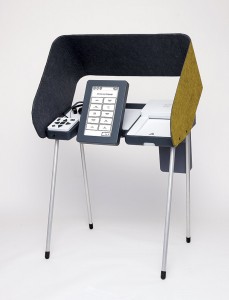iVote
< < Go Back
Los Angeles County has designers looking at the voter experience and upgrading election technology accordingly. But in a tightly regulated business dominated by just four companies, could it happen nationwide?
Last year, a bipartisan commission established by President Obama declared that the U.S. faces an “impending crisis in voting technology.”
Now, Los Angeles County, the largest voting jurisdiction in the U.S., has hired IDEO, a design company with roots in Silicon Valley, to overhaul how it serves up democracy. IDEO has developed a touchscreen system that incorporates features familiar to voters used to scrolling and tapping. Election administrators across the country are closely watching the experiment. They want to know if L.A. can solve the problem of American voting. “For a long time people muttered that somebody should do something about this,” says Doug Chapin, who runs the University of Minnesota’s Program for Excellence in Election Administration. “What Los Angeles County is doing is just that.”
After the 2008 election drew record numbers to the polls, Dean Logan, L.A.’s top election official, decided it was time to replace the county’s obsolete machines, which are based on technology developed in the late 1960s.
Logan has adopted IDEO’s philosophy and practices, such as keeping multicolored Post-it notes in his car for brainstorming sessions on the fly. “We wanted to focus on the voting experience,” he says. “We know if you have a bad experience the first time you vote, you have a lower chance of coming back.”
Los Angeles County has about 5 million registered voters, more than most states, and must print ballots in 11 languages, including Hindi, Khmer, and Tagalog. On any given election day, the county can print as many as 300 different ballots to cater to local races. And California’s ballots are long; in some years more than a dozen initiatives can be up for a vote alongside national, state, and local candidates, maxing out the number of questions that fit on the paper ballots.
IDEO studied voter behavior and found that, given California’s supersize ballots, people often arrive on Election Day with marked-up sample ballots. For those people, “voting is an exercise in transcription,” says Matt Adams, who’s leading the L.A. project. That prompted IDEO to create an interactive sample ballot voters can fill out on a computer or using a mobile app. When they go to vote, they can scan their code, like an airline boarding pass, from a paper printout or phone to automatically select their votes.
More From Bloomberg Businessweek:




